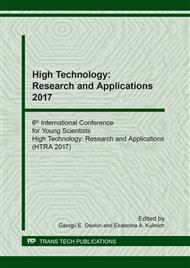p.128
p.134
p.141
p.146
p.152
p.161
p.166
p.172
p.181
Influence of SiO2 Micro- Particles on Microstructure, Mechanical Properties and Wear Resistance of UHMWPE Based Composite under Dry Sliding Friction
Abstract:
This research investigated the influence of silicon dioxide (SiO2) with particle size of 5 micron on microstructure, mechanical properties and wear resistance of UHMWPE polymeric composite materials under dry sliding friction that was tested by Block–on–ring technique according to ASTM G77. Bulk UHMWPE composite specimen was reinforced with SiO2 particles by weight fraction of 0.1, 0.2, 0.3, 0.4, 0.5, 1, 2, 3, 4 and 5 wt.%. Specimen was performed by hot compression process with the compression forming conditions at the temperature of 202°C, pressure of 9.7 MPa and exposure time of 77 minutes. It was found that, SiO2 particle fraction in the range of not exceed than 0.5 wt.% did not affect to change microstructure of the specimen, which its microstructure did not significantly different from the initial UHMWPE specimen due to SiO2 particles were dispersed uniformly in the UHMWPE matrix. Its microstructure appeared in a spherulitic structure pattern. However, the increasing of SiO2 more than 0.5 wt.% affect to changed microstructure due to the SiO2 particles separated from the matrix and accumulated on the UHMWPE matrix. For the case of mechanical and wear resistance properties, the increasing of SiO2 particle of 0.5-1 wt.% affect to increased various mechanical properties to have a highest value and lowest wear rate as compared with initial UHMWPE up to 1.7 times. After that, the increasing of SiO2 particle affect to mechanical properties and wear resistance were decreased, except for the hardness that continuously increased according to the increasing of SiO2.
Info:
Periodical:
Pages:
152-157
Citation:
Online since:
April 2018
Keywords:
Price:
Сopyright:
© 2018 Trans Tech Publications Ltd. All Rights Reserved
Share:
Citation:


